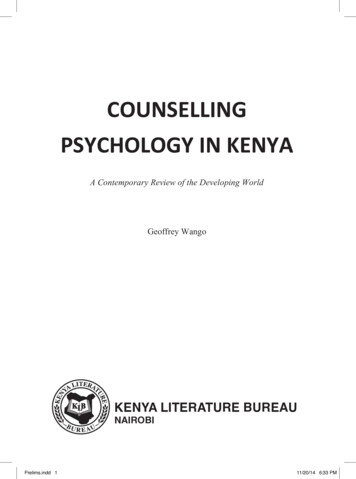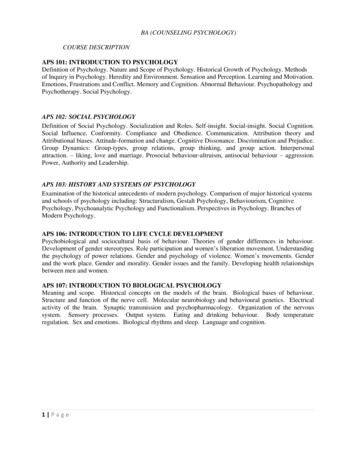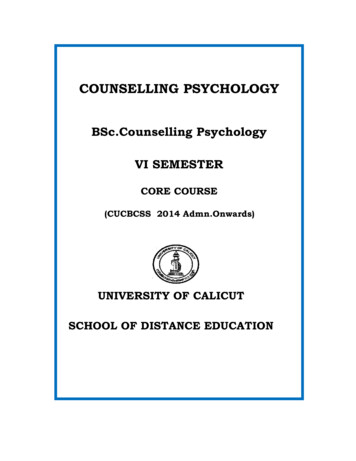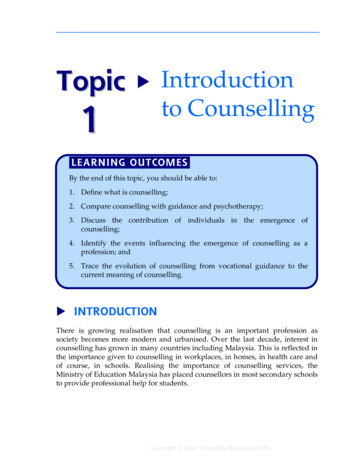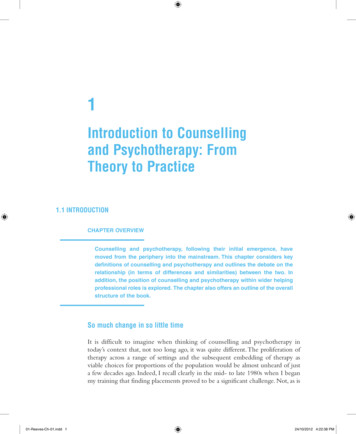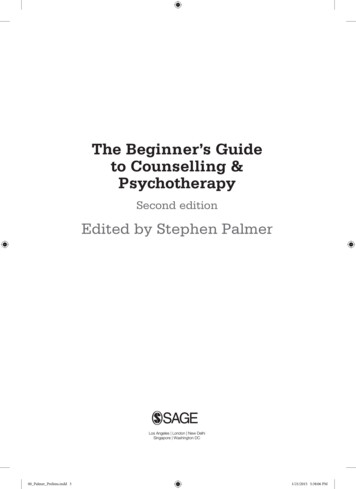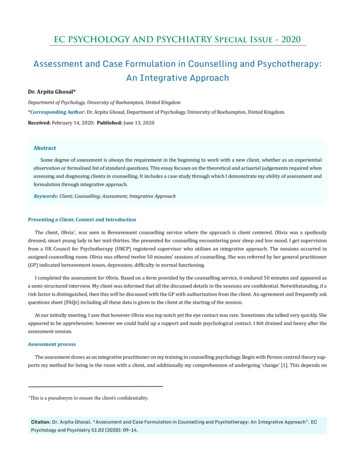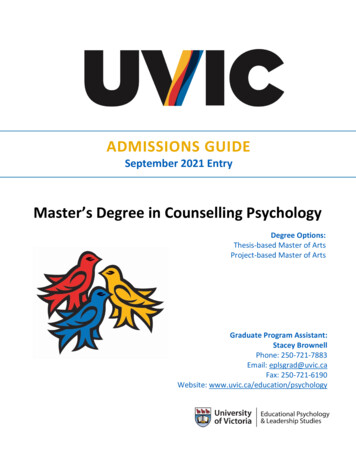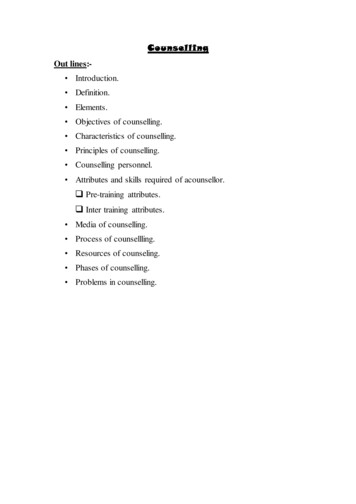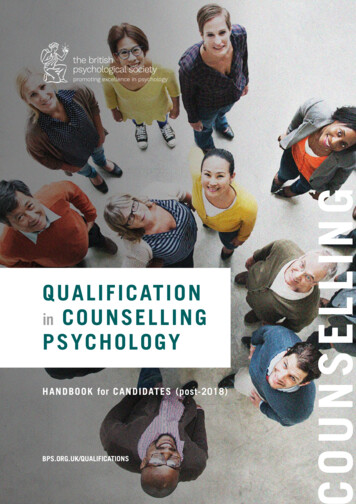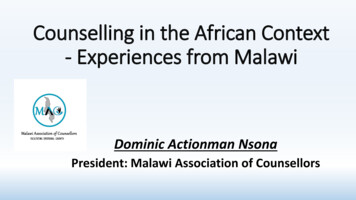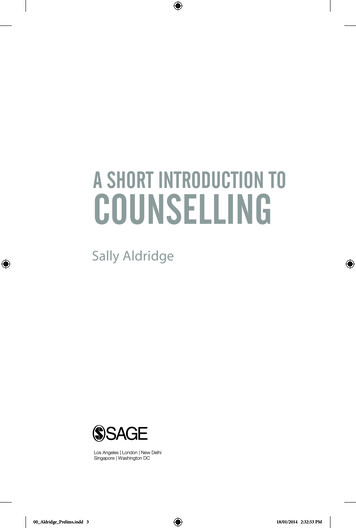
Transcription
A SHORT INTRODUCTION TOCOUNSELLINGSally Aldridgealdridge SITP.indd 400 Aldridge Prelims.indd 307/11/2013 14:0818/01/2014 2:32:53 PM
1 WHAT IS COUNSELLING?INTRODUCTIONTaxi driver to passenger: ‘What do you do?’Passenger: ‘I’m a counsellor.’Taxi driver: ‘A town councillor?’Passenger: ‘No. You’ve heard of Relate, Marriage Guidance Counselling? Welllike that but for all sorts of problems.’This dialogue captures some of the difficulties counselling has in definingitself. One of the problems is that the term ‘counselling’ is used in contextsother than the therapeutic: a debt counsellor gives you debt advice and helpwith employment and consumer law. Google ‘counsellor’ and the fourthand fifth entries are for ‘travel counsellors’ who will sell you a holiday.Members of the public seeking counselling know the difference and arevery unlikely to ask you about the thermal properties of new windows.This chapter addresses the question ‘What is counselling?’ from a number of perspectives, starting with a range of definitions of counselling andthe terms in common use to describe the therapies. There is a brief accountof the origins and development of counselling that also traces the separationof counselling from other forms of helping such as guidance and befriending in the 1990s. The chapter then looks at some of the different views of thenature and purpose of counselling within the field and considers the socialand political dimensions of counselling. Finally it describes the positionsheld on the difference between counselling and psychotherapy. Throughout,this book is about working with individuals rather than couples or groups.Counselling has been a feature of everyday life since the second half ofthe twentieth century and yet even when experts are employed to carryout the task, they find that ‘the counselling sector is difficult to define’(ENTO 2008: 29). Despite, or perhaps because of this, it is estimated thatthere are 100,000 people delivering therapy in the United Kingdom(Mental Health Foundation, Mind et al. 2006), the majority describingwhat they do as counselling.01 Aldridge Ch-01.indd 118/01/2014 2:34:01 PM
2A SHORT INTRODUCTION TO COUNSELLINGDEFINITIONS OF COUNSELLINGThere are several definitions of counselling in circulation. Some areexclusive to counselling, some are inclusive of all the talking therapiesand some seek to differentiate between the various talking therapies.Most of the definitions of counselling below are written by professional organisations and reflect the views of their members; or byorganisations and government agencies and reflect the services onoffer. The first two British Association for Counselling/BritishAssociation for Counselling and Psychotherapy (BAC/BACP) definitions from 1978 and 2013 illustrate the development of counsellingduring that time.1978 Definition by the Standing Conference for the Advancement ofCounselling/British Association for Counselling‘Counselling takes place when one person accepts responsibility for helping another to decide upon a course of action or to understand or changepatterns of behaviour which distress, disturb or affect his social behaviour.’The definition continues to describe when counselling takes place andstates that counselling may be ‘incidental to the other functions of theprofessional’ for example a teacher and pupil. It may be ‘educational andvocational guidance, provided by a specialist service for particular problems or within voluntary agencies’ (Standing Conference for theAdvancement of Counselling 1978).2013 BACP Definition OneCounselling and psychotherapy are umbrella terms that cover a range oftalking therapies. They are delivered by trained practitioners who work withpeople over a short or long term to help them bring about effective changeor enhance their wellbeing.Therapy is time set aside by you and the therapist to look at what hasbrought you to therapy. This might include talking about life events (past andpresent), feelings, emotions, relationships, ways of thinking and patterns ofbehaviour. The therapist will do their best to help you to look at your issues,and to identify the right course of action for you, either to help you resolveyour difficulties or help you find ways of coping. Talking about these thingsmay take time, and will not necessarily all be included in one session. Thenumber of sessions offered may be limited, and so it is best to ask about thisin advance, for example, brief therapy or short term therapy might provide amaximum of 6, 8, 10 or 12 sessions. )01 Aldridge Ch-01.indd 218/01/2014 2:34:01 PM
WHAT IS COUNSELLING?32013 BACP Definition TwoCounselling takes place when a counsellor sees a client in a private andconfidential setting to explore a difficulty the client is having, distress theymay be experiencing or perhaps their dissatisfaction with life, or loss of asense of direction and purpose. It is always at the request of the client as noone can properly be ‘sent’ for counselling.By listening attentively and patiently the counsellor can begin to perceivethe difficulties from the client’s point of view and can help them to see thingsmore clearly, possibly from a different perspective. Counselling is a way ofenabling choice or change or of reducing confusion. It does not involve giving advice or directing a client to take a particular course of action.Counsellors do not judge or exploit their clients in any way.In the counselling sessions the client can explore various aspects of theirlife and feelings, talking about them freely and openly in a way that is rarelypossible with friends or family. Bottled up feelings such as anger, anxiety,grief and embarrassment can become very intense and counselling offers anopportunity to explore them, with the possibility of making them easier tounderstand. The counsellor will encourage the expression of feelings and asa result of their training will be able to accept and reflect the client’s problems without becoming burdened by them.Acceptance and respect for the client are essentials for a counsellor and, asthe relationship develops, so too does trust between the counsellor and client,enabling the client to look at many aspects of their life, their relationships andthemselves which they may not have considered or been able to face before.The counsellor may help the client to examine in detail the behaviour or situations which are proving troublesome and to find an area where it would bepossible to initiate some change as a start. The counsellor may help the clientto look at the options open to them and help them to decide the best for g.php)MIND (the mental health charity) DefinitionCounselling provides a regular time and space for people to talk about theirtroubles and explore difficult feelings, in an environment that is dependable,free from intrusion and confidential. A counsellor should respect your viewpoint, while helping you to deal with specific problems, cope with crises,improve your relationships, or develop better ways of living. Despite thename, counsellors don’t usually offer advice. Instead, they help you to gaininsight into your feelings and behaviour and to change your behaviour, ifnecessary. They do this by listening to what you have to say and commentingon it from their particular professional perspective. The word ‘counselling’ covers a broad spectrum, from someone who is highly trained to someone whouses counselling skills (listening, reflecting back what you say, or clarifying) aspart of another role, such as nursing. We use the term here to mean a talkingtherapy delivered by a trained professional. Sessions usually take place once01 Aldridge Ch-01.indd 318/01/2014 2:34:01 PM
4A SHORT INTRODUCTION TO COUNSELLINGa week. Making this regular commitment gives you a better chance of findingout why you are having difficulties. (Catty 2010)United Kingdom Council for Psychotherapy’s (UKCP) definition ofpsychotherapeutic counsellingPsychotherapeutic Counselling is distinguished from traditional counsellingby its emphasis on the co-creation of an in-depth therapeutic relationship;wherein the suffering human being is viewed holistically, body, mind andsoul and in the context of a concrete life situation and developmental stage.When training as a psychotherapeutic counsellor there is particular reference to establishing and maintaining the therapeutic relationship, which is thecentral factor in the work. selling.html)Royal College of Psychiatrists’ definitionCounselling is a general term for exploring emotional problems by talking themthrough with a trained counsellor or therapist. The term covers a considerablerange of approaches. In its simplest form, this can be supportive and sympathetic listening in the form of weekly sessions over a small number of weeks. Thissort of counselling is suited to people with fundamentally healthy personalitieswho need help in addressing a current crisis in their life or relationships.Some more experienced counsellors, who have had further training in anyof a large range of theoretical approaches, work in a deeper way, and are ableto help people with more complex problems. unsel)In all of these definitions counselling is a term used to describe a helpingrelationship. One person, ‘the client’, has an issue or a problem, somethingthat he or she cannot deal with alone. The ‘client’ approaches the ‘counsellor’for help in a formal confidential relationship. The purpose of this relationship is to help the ‘client’ address or deal better with his or her issues.The client’s definition of counsellingWhile most people seem to know what counselling is, when asked, thereare few definitions of counselling written by clients. Those that exist derivefrom research and market research into what clients want from counselling. Clients want to be treated with respect, to be understood and helpedto resolve problems. Counselling provides another person who is willing tohelp the client do that. Clients want a counselling relationship that treatsthem as individuals with acceptance and hope (Brainchild UK Ltd 2008).01 Aldridge Ch-01.indd 418/01/2014 2:34:01 PM
WHAT IS COUNSELLING?5A BACP-commissioned project with clients produced many images of theirhopes for therapy – the one I remember is a blue velvet armchair with armslike wings. Several others showed journeys from dark places to the light(Forsythe and Corfino 2008: 28). These provide the clients’ ideas of goodcounselling as being an empathic non-judgmental relationship; a processthat will give hope and help people to feel better (Forsythe and Corfino2008: 26). In summary it has proved almost impossible to come up with adefinition that is boundaried, succinct and clear. There is not the sameproblem of definition with ‘psychology’, ‘psychiatry’ or ‘psychotherapy’.There is a different problem for these groups – any word with ‘psy’ at thebeginning is taken to imply mental illness (Forsythe and Corfino 2008).THE TALKING OR PSYCHOLOGICAL THERAPIESCounselling is one of the groups of occupations described as TalkingTherapies and Psychological Therapies, together with psychiatry, clinicaland counselling psychology and psychotherapy. Talking Therapies andPsychological Therapies are terms used in the literature of the Departmentsof Health of the four home countries and of charitable organisations dealing with mental health such as MIND. MIND, for example, uses the term‘talking treatments’ and includes within this psychotherapy, counsellingand therapy stating that,the terms ‘talking treatment’ or ‘talking therapy’ or ‘psychological therapy’ cover treatments that you may know as psychotherapy counselling therapy.MIND also lists the titles a ‘specially trained mental health professional’might work under: herapist (www.mind.org.uk/mental health a-z/7972 making senseof talking treatments)Some people see counselling as a non-professional activity, as an everydayrelationship that does not require training, only human understanding anda willingness to help in dealing with another person’s hurt and distress.01 Aldridge Ch-01.indd 518/01/2014 2:34:02 PM
6A SHORT INTRODUCTION TO COUNSELLINGOthers, see counselling as an equal partner with psychotherapy, psychologyand psychoanalysis. Some in these professions regard counselling as a juniorpartner, dealing with simpler problems more quickly. Some commentatorshave presented counselling as the future hope for society, the replacementfor organised religion and the extended family and as such an agent to support social cohesion (Halmos 1964; 1967). Counselling is seen as a responseto the increased emphasis in society on the individual rather than the familyor community. This has led to a number of views critical of the role of counselling. One view sees it as weakening the moral fibre of the population,making people into therapy junkies unable and unwilling to take responsibility for themselves (Furedi 2004). The government has had its own ideasabout counselling and the role the talking therapies can perform (Departmentof Health 2007, 2008).Counsellors themselves can find it difficult to say what counselling is,finding it easier to describe what counsellors do, the process and thehoped for outcomes. Some steer away from intended outcomes fearingthis may seem that we will be directing clients to outcomes we see ashoped for and thus denying them autonomy.Below are some of the things I have said in answer to the question‘What is counselling?’‘I help people work through their issues, difficulties.’ This sounds very easyand simple.‘I listen to people and let them know what I have heard and understoodfrom what they tell me.’ This sounds easy, and if I add ‘what they haven’tsaid’ it can sound scary too.‘I accept the person and don’t judge their behaviour, but try to build a trusting relationship so the client can be open with me.’ This sounds a bit superior and research tell us that clients choose not to tell us everything.My honest answer to the question ‘What is counselling?’ is that counselling is hard work.THE DEVELOPMENT OF COUNSELLING IN THE UNITEDKINGDOMCounselling is a social phenomenon of the latter part of the twentieth century, arising from the social, cultural and economic changes that began in thenineteenth century. These changes led to a reduction in the place of organised religion in the everyday life of many people. As the expectation andpatterns of life changed, it became the norm for women to work rather thanstay at home. The support networks of family and neighbours weakened as01 Aldridge Ch-01.indd 618/01/2014 2:34:02 PM
WHAT IS COUNSELLING?7families broke apart and people moved away from the family home for work.People began to employ ‘professionals’ to do tasks they would have previously done themselves, for example painting and decorating, car maintenance and help with emotional difficulties. The result was a society in whichpeople had more freedom and choice than earlier generations but the traditional sources of support, such as the extended family, the church and jobsfor life had disappeared for many. The Welfare state and the National HealthService introduced after the Second World War came to provide an alternative to the support networks lost (Perkin 2002).In order to understand the difficulty in the definition of counselling itis necessary to understand the origins and development of counselling inthe United Kingdom. Many people equate the origins of counselling in theUnited Kingdom with the arrival of Carl Rogers’ client-centred therapy inthe late 1950s and 1960s. In fact, counselling had had a long and variedexistence since the late nineteenth century and early twentieth centuryunder other names.Trying to identify the roots of counselling is similar to finding thesource of the Nile. There are competing claims. What follows is a veryshort summary of the sources.Counselling in the United Kingdom has deep historical roots originating in the various forms of help offered to the poor, both deserving andundeserving. This help came from the volunteers of the CharityOrganisation Society (COS) and Police Court Missionaries. The courtmissionaries and Temperance officers were attached to police courts tohelp people found guilty of drunkenness. These workers were often linkedto and employed by established churches in the early years. The COS volunteers, who were mainly middle-class women, worked with poor families and by the end of the nineteenth century were using what would berecognised today as a case work approach. These two groups developedinto social workers and probation officers, with formal training for bothintroduced as early as 1903.A second tributary arose from the spread of psychoanalytic ideas to treatsoldiers suffering from shellshock after the First World War and the influence of the ideas of the Eugenics movement. These were put into practicein Child Guidance Clinics where by the 1930s psychiatric social workerswere delivering psychodynamic therapy to clients. There was an increase inmarriage breakdown and sexual violence after demobilisation of troopsfrom the Second World War, leading to government anxiety about a potential threat to social cohesion (Hennessy 2007). This led to governmentfunding for Marriage Guidance organisations, which were being overwhelmed by the demand for help. In order to have some confidence in thequality of the support on offer a Council was established to oversee trainingfor the volunteer marriage guidance counsellors (Herbert and Jarvis 1970).01 Aldridge Ch-01.indd 718/01/2014 2:34:02 PM
8A SHORT INTRODUCTION TO COUNSELLINGThe introduction of the National Health Service and the Welfare statebrought about a major change in the expansion of support services available to everyone, not just the poor. Social workers, psychiatric socialworkers, probation officers and clinical psychologists became stateemployed professionals. Others remained within the pastoral and charitable sectors and the Marriage Guidance Councils. In the immediate postwar period, most of these activities were not called ‘counselling’. The termcounselling came into use gradually after 1945 in the United Kingdom,especially in the Marriage Guidance Councils. Its use became more common with the arrival of Rogers’ client-centred counselling.From the 1960s onwards counselling expanded in the United Kingdom.As a result of the Newsome Report in 1963 and lobbying by the NationalAssociation for Mental Health (later to become MIND) postgraduatecourses were set up in universities to train school counsellors. This wasparalleled by the expansion of Marriage Guidance Councils and in thesame period several religious based organisations were established andbegan to offer training, for example the Westminster Pastoral Foundation(WPF) and the Clinical Theology Association (CTA).By the late 1960s this uncontrolled expansion of counselling was causing concern, as there were no common training standards or any definition of counselling. Government and charitable funding was provided toset up a Standing Conference for the Advancement of Counselling(SCAC). The organisations joining SCAC shows the breadth and range ofcounselling; it included universities, colleges, schools, professional organisations, psychoanalytic organisations, the medical colleges, governmentdepartments, the churches, Trade Unions, any and every organisationwith an interest in counselling. In 1977 SCAC became the BritishAssociation for Counselling (BAC).The wide range of interest groups in SCAC helps to explain why counselling often has a context-derived adjective attached to it, such as schoolcounsellor, marriage guidance counsellor. It also helps to understand howcounselling came to be used indiscriminately as an umbrella term toencompass a wide set of activities, many of which would not be seen ascounselling today.In the 1980s the government set up the National Council for VocationalQualifications (NCVQ) and introduced a national framework for vocational qualifications (NVQs) to be delivered in the vocational sector, thatis schools and Further Education colleges, not universities (see Chapter 5).‘Vocational’, in this context, did not mean ‘a calling’ such as people feelwho are drawn to entering a religious order, but vocational in the sense ofskills-based, in contrast to academic- or thinking- and writing-based (seeChapter 2). The field of helping activities – counselling, befriending,counselling skills, advice, guidance and mediation – came together, and01 Aldridge Ch-01.indd 818/01/2014 2:34:02 PM
WHAT IS COUNSELLING?9the first step was a project to differentiate between these activities (Russell,Dexter et al. 1992).Counselling was defined in the Differentiation Project as,an activity entered into by a person seeking help, it offers the opportunityto identify things for the client themselves that are troubling or perplexing.It is clearly and explicitly contracted, and the boundaries of the relationshipidentified. The activity itself is designed to help self-exploration and understanding. The process should help to identify thoughts, emotions andbehaviours that, once accessed, may offer the client the opportunity for agreater sense of personal resources and self determined change. (Russell,Dexter et al. 1992: 6)In contrast, Counselling Skills were defined as,high level communication, interpersonal and social skills used intentionallyin a manner consistent with the goals and values of counselling ethics. Theprincipled use of these skills facilitates the client’s purpose and enhancespersonal understanding of themselves and/or situations. As a direct result ofusing counselling skills the professional role of the user will be enhanced.(Russell, Dexter et al. 1992: 7)Befriending was defined as being informal and opposed to professionalisation. Befriending has friends not clients: ‘It seeks to share the problemor issue rather than manage or solve it’ (Russell, Dexter et al. 1992: 5).In contrast the working definition of guidance, while including thedevelopment of client self-awareness, stressed other aspects of the role,including ‘To enable the client to be aware of and have access to accurateappropriate information on available opportunities in order to makeinformed choices’ (Russell, Dexter et al. 1992: 7).The Differentiation Project established counselling as a distinct activitywith a set of competences that were developed into National VocationalQualifications for counselling. These sit in a National Qualifications Frame work to be delivered in the Further Education sector. Previously, counsellor training had been postgraduate courses delivered by universities or thequalifications of private training organisations such as Relate and WPF. Inthe 1990s the introduction of NVQs and other related qualifications led toan increase in the number and range of counselling qualifications, whichwere widely available in local Further Education Colleges. Many of thesecourses were and remain qualifications in counselling skills at Levels 2 and3 on the Qualification and Credit Framework (QCF) (the Scottish Creditand Qualifications Framework (SCQF) in Scotland); others are professional training courses (see Chapter 3 on Training). When the output ofall the training courses that aim to produce qualified counsellors and01 Aldridge Ch-01.indd 918/01/2014 2:34:02 PM
10A SHORT INTRODUCTION TO COUNSELLINGpsychotherapists are added together, about 5,000 new counsellors andpsychotherapists enter the field each year.There was, however, a downside to this: the introduction of vocationalqualifications in counselling contributed to a belief that counselling hadno theoretical base, but was a set of skills to be acquired. This has persistedin a view that what a counsellor does depends on the setting of the work,not on any theoretical concepts and training. The increase in bothdemand and provision of counselling stimulated critical comment andobservations on the nature and purpose of counselling and its function insociety. For some, counselling in a social context, is ‘a liberatory movement, committed to wresting power and authority from those who haveassumed positions of authority in relation to ordinary peoples’ everydaylives’ (Bondi 2004). The goal of counselling is to facilitate the client’sempowerment so that he/she can change their situation. This view sitsalongside the view that counselling originally was ‘an avowedly lay practice, constituted as something wholly different from a profession, andtaking particular care to avoid making practitioners experts’ (Bondi 2004:320–1). There are strongly held views that the counselling relationshipshould be of equals, without hierarchy or expertise, embedded in everydaywork (McLeod 2009). Professionalisation is anathema to counsellors whohold these beliefs; it represents the abandonment of the anti-authoritarianprinciples from which counselling sprang. Some voluntary counsellorsoppose payment believing something would be lost if it was not voluntary:‘Volunteers do it for no other reason than the love of it, the desire for thatrelational contact’ (Bondi 2004: 329). This view sees counselling as a process of mutual aid between peers, where one person is in distress or facingdifficulties.Allied with this view of counselling as a social movement is the opposition to the imposition of a medical model on counselling, with the idea ofillness rather than dis-ease, diagnosis and treatment of symptoms withmanuals for the treatment of each condition, approved centrally. Thisstrongly held view believes in seeing the client as a whole rather than apresentation of symptoms, and within his/her social and cultural settingrather than as an individual in isolation.Other views look at counselling in terms of its function in culture andsociety. Two of these views are presented here. The first sees counsellingas a negative force in society, and the second sees it as an inadvertent agentof the state whose function is to support social stability.Counselling, together with the other psychological therapies, psychiatry, psychology, and psychotherapy are accused of ‘manufacturing victims’and creating a self-perpetuating business (Dineen 1999), setting themselves up as authorities in happiness and health (Evans 1999). The psychological therapies are seen as responsible for weakening the moral fibre of01 Aldridge Ch-01.indd 1018/01/2014 2:34:02 PM
WHAT IS COUNSELLING?11the population, by turning ordinary life events into problems that needexpert psychological help to deal with, for example: ‘A change in individual circumstance is often elevated into a problem that requires professional support’(Furedi 2004: 108). As traditional social support networksbecome less available, and people have lower expectation of their existingrelationships, individuals are encouraged to use therapists as an alternative rather than dealing with the issues themselves. Thus ‘therapeuticculture helps foster the perception of the self – as uniquely vulnerable andweak’ (Furedi 2004: 105). In this argument the aim of counselling toempower the client towards understanding and autonomy is negated bythe sense of helplessness created by this ‘therapy culture’. The medicalisation of unhappiness and distress by the kind of diagnoses in the Diagnosticand Statistical Manual of Mental Disorders (DSM) means that individualsare not only unhappy and not coping, they are also diagnosed as sick.Commentators like Dineen (1999) and Furedi (2004) see the therapies asa self-serving business, with a vested interest in keeping clients helplessand dependent.Another view of the therapies arises from the growth in emphasis onthe individual in society and the use made of this by government. Inother words, this is the direct opposite of the views that counselling is asubversive activity. There are two main strands to this proposition. Whenthe subjective experience of the individual becomes of primary importance, that internal individual focus takes away attention from largerissues. People see problems as personal and their responsibility to resolve,rather than as the result of government policies (Rose 1985, 1990;Foucault 1991). This acts to stifle dissent, as dissatisfied individuals arenot politically active but engrossed in their own counselling. The socialand cultural value of giving so much attention to the private self is validated by a culture that encourages and applauds the celebrity private/public self revelations.The perspective of government on counselling and the other psychological therapies is that such psychological interventions may be useful if theycan increase the wellbeing and functioning of the public. Government worksto bring individual hopes, desires and fulfilment into line with its politicalgoals and by so doing avoids any dissent. Counselling plays a role in maintaining this social stability by enabling the individual to regulate him/her selfto fit in with the moral values and political principles of the day.This may be difficult to swallow, but for evidence look at the changinggoal of the Marriage Guidance Council/Relate – even the name showshow it changed from a goal of preserving marriages to working with relationships. In the recession of the 1970s the government invested in counselling for the unemployed and young people. The Improving Access toPsychological Therapies (IAPT) project 2008–12 can be interpreted in this01 Aldridge Ch-01.indd 1118/01/2014 2:34:02 PM
12A SHORT INTRODUCTION TO COUNSELLINGway as a project to reduce the benefits bill through the delivery of certaintypes of therapy (Layard 2006; IAPT 2012). It was argued that the talkingtherapies, Cognitive Behavioural Th
and counselling psychology and psychotherapy. Talking Therapies and Psychological Therapies are terms used in the literature of the Departments of Health of the four home countries and of charitable organisations deal-ing with mental health such as MIND. MIND, for example, uses the term .
